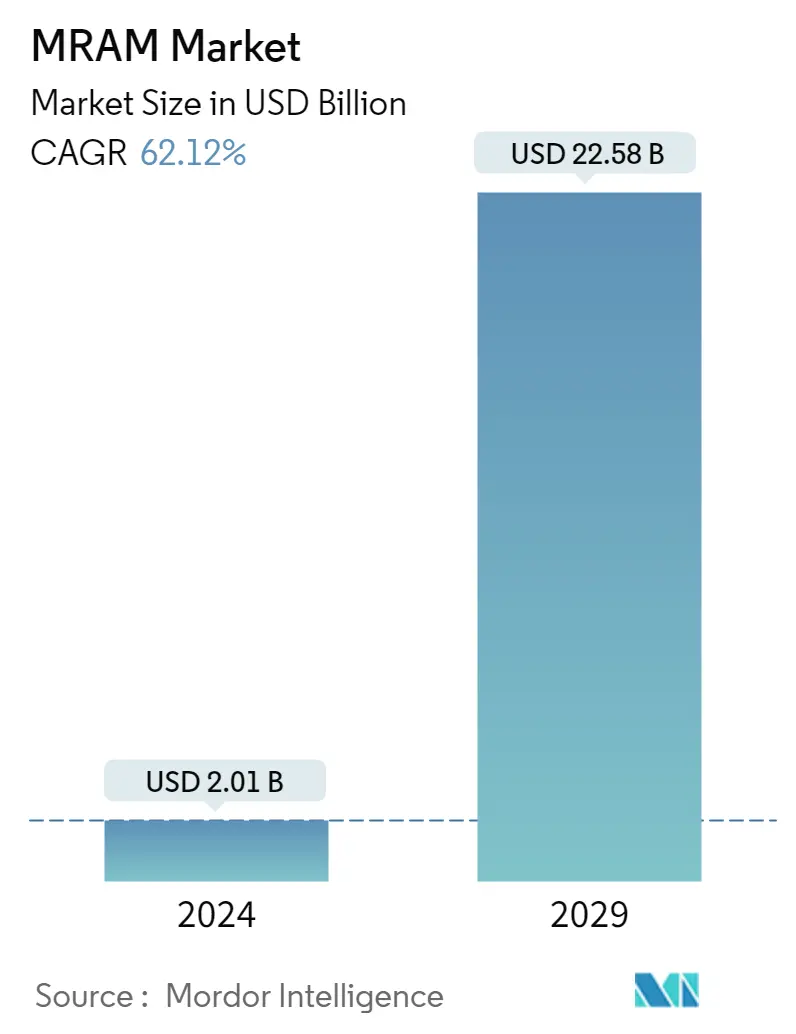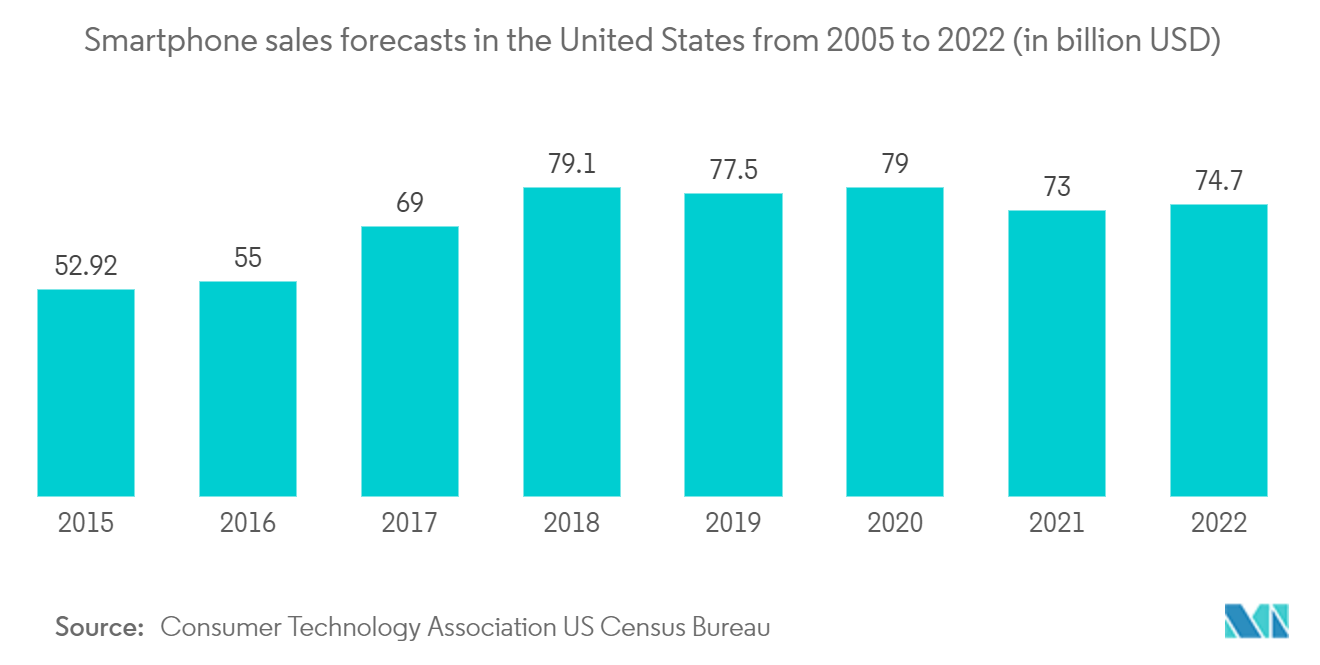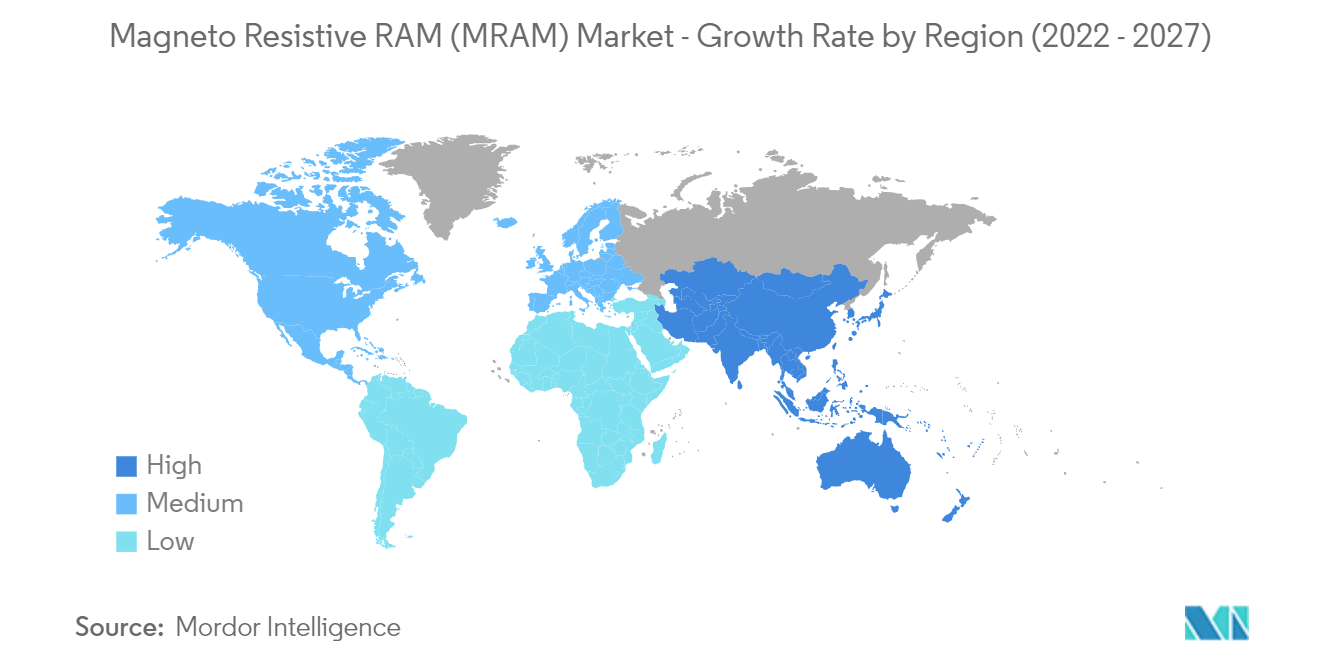Magneto Resistive RAM (MRAM) Market Size

| Study Period | 2019 - 2029 |
| Market Size (2024) | USD 2.01 Billion |
| Market Size (2029) | USD 22.58 Billion |
| CAGR (2024 - 2029) | 62.12 % |
| Fastest Growing Market | Asia Pacific |
| Largest Market | North America |
Major Players
*Disclaimer: Major Players sorted in no particular order |
Magneto Resistive RAM (MRAM) Market Analysis
The MRAM Market size is estimated at USD 2.01 billion in 2024, and is expected to reach USD 22.58 billion by 2029, growing at a CAGR of 62.12% during the forecast period (2024-2029).
Increasing adoption of digitalization across the industry, technological advancement of computing technologies, Internet of Things (IoT) and rapid development of smart robots across the world, and rising investment in electronic devices such as smartphones, televisions, smart wearables, computers, and drones, may boost the market demand in the future.
- The need for low-cost, small-size, power-efficient random-access memory technology grew in the past decade in industrial, commercial, automotive, and defense systems due to the rapid implementation of computers. MRAMs can withstand high radiation, operate in extreme temperature conditions, and are tamper-resistant, making them fit for military and industrial applications.
- Growing investments in the research and development of next-generation read access memory may open provide opportunities to new product applications and fuel the market's growth.
- The global adoption of smartphones has encouraged manufacturers to develop advanced RAM that could reduce the boot-up time and enhance memory space to offer high performance. The number of key players in the market has grown, focusing on developing and mass-producing MRAM either in stand-alone or embedded design to gain a leading position in the market in the future.
- Despite the COVID-19 outbreak, which negatively impacted the smartphone industries but spurred demand for server and PC memory for stay-at-home activities, the year 2020-2021 was expected to see recovery. Driven by important megatrends such as cloud computing, AI, and the IoT, the memory market experienced extraordinary growth in the past decade.
- According to Intel, the increased need for virtualized desktop infrastructure and virtualized storage solutions is driving the demand for its storage and memory products in data centers. The need to enhance and accelerate storage and memory capabilities for the two application types grew due to the rising trend of work-from-home and the increased usage of digital resources during the COVID-19 pandemic.
Magneto Resistive RAM (MRAM) Market Trends
This section covers the major market trends shaping the Magneto Resistive RAM (MRAM) Market according to our research experts:
Consumer Electronics May Experience Significant Growth
- Consumer electronics may experience significant growth due to technological advancements, penetration of IoT, the emergence of 4G and 5G technologies, and innovation in various devices to increase memory capacity and power efficiency. Smartphones, laptops, smart wearables, and digital cameras are expected to gain popularity due to increased disposable income and the rising adoption of smart devices.
- Global adoption of smartphones has encouraged manufacturers to develop advanced RAM that could reduce the boot-up time and enhance the memory space to offer high performance. The number of key players in the market has grown, focusing on developing and mass-producing MRAM either in stand-alone or embedded design to gain a leading position in the market in the future.
- For instance, recently, Samsung has started mass producing its first commercial embedded magnetic RAM (eMRAM). As eMRAM does not require an erase cycle before writing data, it is 1,000 times faster than eFlash with lower voltage, providing a promising opportunity for its implementation in an upcoming smartphone.
- Among the established and emerging embedded memory technologies, STT MRAM is very promising, as it offers a combination of persistence, low power consumption, high speed, and high endurance, ideal for low-power microcontrollers wearables and gaming and IoT devices.

North America May Hold a Significant Market Share
- North America is projected to experience growth in the magneto-resistive RAM market during the forecast period. Large, small, and medium enterprises are moving toward cloud-based services to reduce the costs related to technology infrastructure and streamline operations. This contemporary shift is boosting the growth of data centers with lower power consumption and encouraging MRAM implementation as it does not require refreshing and allows low-power states.
- As MRAM technology is robust and reliable over extreme temperature ranges, its demand for memory products in the automotive sector is increasing. Everspin provided a 4MB MRAM chip (MR2A16AMYS35) to BMV for its superbike. It is also used in various automotive applications, such as engine control units, advanced transmission control in-car data logs, and multimedia systems for in-car entertainment.
- MRAM technology is also implemented in medical devices to provide next-generation sensors with higher sensitivity, accuracy, and noise reduction. These sensors are used for non-invasive diagnostic testing of blood, body fluids, and tissue for medical conditions, including diabetes and hypoxia.
- The rapid adoption of IoT devices in medical devices to integrate technology for data communication, data storage, and data mining is helping reduce human errors. Therefore, radio-frequency identification (RFID) devices are integrated with MRAM to withstand gamma radiation. An increased number of chronic disease cases in North America are also fueling the growth of the market. According to a report, chronic diseases are among the most prevalent and costly health conditions in the United States, and nearly half (approximately 45%, or 133 million) of the American population suffer from at least one chronic disease.
- The COVID-19 pandemic also affected most industries worldwide. However, it boosted the growth of robots, drones, and other automated machines used to fight the virus. The outbreak led to an increasing adoption of assistive robots in hospitals and testing facilities to disinfect hospitals and residential areas, monitor temperature, and deliver food and medicines to COVID -19 patients. It also relieved hospital staff from non-essential tasks and helped limit the spread of the virus. For instance, Spot, a robot by Boston Dynamics, helps Boston's healthcare workers by providing assistance in treating infected patients. Boston Dynamics also announced its plans to expand the use of its robots to other hospitals.

Magneto Resistive RAM (MRAM) Industry Overview
The magneto resistive RAM (MRAM) market is competitive. The major players with a prominent market share are focusing on expanding their customer base across foreign countries. These companies are leveraging strategic collaborative initiatives to increase their market share and profitability. However, with technological advancements and product innovations, mid-size to smaller companies are increasing their market presence by securing new contracts and tapping new markets.
- January 2022 - Samsung Electronics, a world leader in advanced semiconductor technology, demonstrated the world's first in-memory computing based on MRAM (Magneto-resistive Random Access Memory). The research was carried out by the Samsung Advanced Institute of Technology (SAIT) in collaboration with the Samsung Electronics Foundry Business and Semiconductor R&D Center. In line with this technological development, Samsung aims to merge memory and system semiconductors for next-generation artificial intelligence (AI) chips, along with strengthening its market position.
- May 2022 - Everspin launched its new product, the EMxxLX xSPI MRAM, a non-volatile memory solution, for applications in industrial IoT and embedded systems. It aims to provide its customers with an alternative to SPI NOR/NAND flash, along with densities ranging between 8MB and 64MB and much faster R/W data rates of up to 400MB/s.
Magneto Resistive RAM (MRAM) Market Leaders
-
Honeywell International Inc.
-
Infineon Technologies AG
-
Intel Corporation
-
Avalanche Technology Inc.
-
Samsung Electronics Co. Ltd
*Disclaimer: Major Players sorted in no particular order

Magneto Resistive RAM (MRAM) Market News
- September 2022 - Avalanche Technology, a next-generation MRAM technology provider, and United Microelectronics Corporation (UMC), a semiconductor foundry, launched their new high-reliability Persistent SRAM (P-SRAM) memory devices through UMC's 22nm process technology. The memory device would be based on Avalanche Technology's latest generation of Spin Transfer Torque Magneto-resistive RAM (STT-MRAM) technology and would offer its customers significant density, reliability, endurance, and power benefits over the existing non-volatile solutions.
- July 2021 - Researchers at IIT Delhi (Centre for Applied Research in Electronics (CARE)) collaborated with the National University of Singapore (NUS) to achieve higher integration density in SOT-MRAMs (spin-orbit torque magneto-resistive RAM). According to researchers, SOT-MRAMs are better than STT-MRAM in terms of reliability and writing speed but not in high integration density.
Magneto Resistive RAM (MRAM) Market Report - Table of Contents
1. INTRODUCTION
- 1.1 Study Assumptions and Market Definition
- 1.2 Scope of the Study
2. RESEARCH METHODOLOGY
3. EXECUTIVE SUMMARY
4. MARKET INSIGHTS
- 4.1 Market Overview
-
4.2 Industry Attractiveness - Porter's Five Forces Analysis
- 4.2.1 Threat of New Entrants
- 4.2.2 Bargaining Power of Consumers
- 4.2.3 Bargaining Power of Suppliers
- 4.2.4 Threat of Substitute Products
- 4.2.5 Intensity of Competitive Rivalry
- 4.3 Value Chain Analysis
- 4.4 Assessment of COVID-19 Impact on the Industry
5. MARKET DYNAMICS
-
5.1 Market Drivers
- 5.1.1 Increasing Demand for Miniaturization of Electronic Devices
- 5.1.2 Increased Use of MRAM in RFID Tags
-
5.2 Market Challenges
- 5.2.1 High Design Cost with Electromagnetic Interface Problems
6. MARKET SEGMENTATION
-
6.1 Type
- 6.1.1 Toggle MRAM
- 6.1.2 Spin-transfer Torque MRAM
-
6.2 Offering
- 6.2.1 Stand-alone
- 6.2.2 Embedded
-
6.3 Application
- 6.3.1 Consumer Electronics
- 6.3.2 Robotics
- 6.3.3 Enterprise Storage
- 6.3.4 Automotive
- 6.3.5 Aerospace and Defense
- 6.3.6 Other Applications
-
6.4 Geography
- 6.4.1 North America
- 6.4.2 Europe
- 6.4.3 Asia-Pacific
- 6.4.4 Latin America
- 6.4.5 Middle-East and Africa
7. COMPETITIVE LANDSCAPE
-
7.1 Company Profiles
- 7.1.1 Avalanche Technology Inc.
- 7.1.2 NVE Corporation
- 7.1.3 Qualcomm Incorporated
- 7.1.4 Crocus Nano Electronics LLC
- 7.1.5 Everspin Technologies Inc.
- 7.1.6 HFC Semiconductor Corporation
- 7.1.7 Tower Semiconductor
- 7.1.8 Honeywell International Inc.
- 7.1.9 Infineon Technologies AG
- 7.1.10 Intel Corporation
- 7.1.11 Samsung Electronics Co. Ltd
- 7.1.12 Spin Transfer Technologies
- 7.1.13 Numem
- *List Not Exhaustive
8. INVESTMENT ANALYSIS
9. FUTURE OF THE MARKET
** Subject To AvailablityMagneto Resistive RAM (MRAM) Industry Segmentation
Magneto resistive RAM (MRAM) is a non-volatile method of storing data bits in random-access memory using magnetic states instead of electrical charges, which is different from dynamic random-access memory (DRAM) and static random-access memory (SRAM), as they maintain data only until the power is applied.
The magneto resistive RAM (MRAM) market is segmented by type (toggle MRAM and spin-transfer torque MRAM), application (consumer electronics, robotics, automotive, enterprise storage, and aerospace and defense), and geography.
| Type | Toggle MRAM |
| Spin-transfer Torque MRAM | |
| Offering | Stand-alone |
| Embedded | |
| Application | Consumer Electronics |
| Robotics | |
| Enterprise Storage | |
| Automotive | |
| Aerospace and Defense | |
| Other Applications | |
| Geography | North America |
| Europe | |
| Asia-Pacific | |
| Latin America | |
| Middle-East and Africa |
Magneto Resistive RAM (MRAM) Market Research FAQs
How big is the MRAM Market?
The MRAM Market size is expected to reach USD 2.01 billion in 2024 and grow at a CAGR of 62.12% to reach USD 22.58 billion by 2029.
What is the current MRAM Market size?
In 2024, the MRAM Market size is expected to reach USD 2.01 billion.
Who are the key players in MRAM Market?
Honeywell International Inc., Infineon Technologies AG, Intel Corporation, Avalanche Technology Inc. and Samsung Electronics Co. Ltd are the major companies operating in the MRAM Market.
Which is the fastest growing region in MRAM Market?
Asia Pacific is estimated to grow at the highest CAGR over the forecast period (2024-2029).
Which region has the biggest share in MRAM Market?
In 2024, the North America accounts for the largest market share in MRAM Market.
What years does this MRAM Market cover, and what was the market size in 2023?
In 2023, the MRAM Market size was estimated at USD 1.24 billion. The report covers the MRAM Market historical market size for years: 2019, 2020, 2021, 2022 and 2023. The report also forecasts the MRAM Market size for years: 2024, 2025, 2026, 2027, 2028 and 2029.
MRAM Industry Report
Statistics for the 2024 MRAM market share, size and revenue growth rate, created by Mordor Intelligence™ Industry Reports. MRAM analysis includes a market forecast outlook to 2029 and historical overview. Get a sample of this industry analysis as a free report PDF download.



